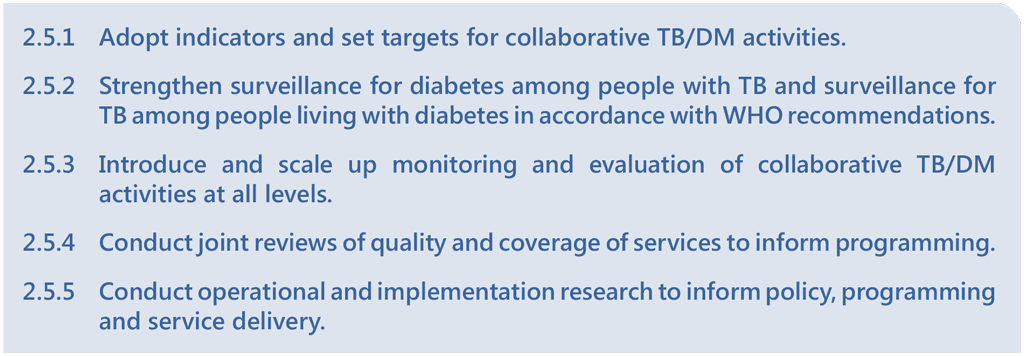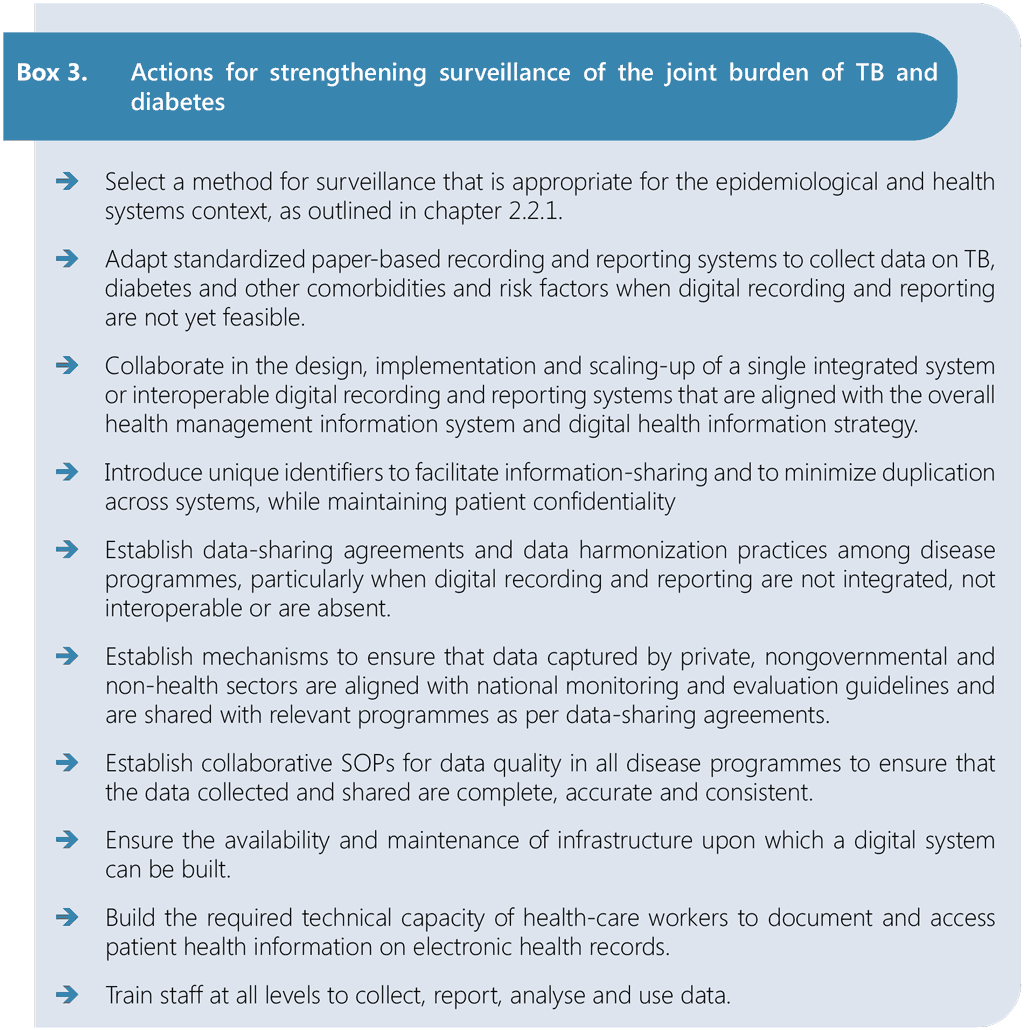Book traversal links for 1266
2.5.1 Adopt indicators and set targets for collaborative TB/DM activities.

Where collaborative TB/DM activities are being established, national programmes should agree on a core set of indicators and tools to collect data for monitoring and evaluating to improve care. Clearly defined indicators can drive progress and accountability, especially if they are linked to established accountability mechanisms, such as the Multisectoral accountability framework for TB (38), and if they are documented in the national strategic plans.
Experience in scaling up collaborative TB/HIV activities shows that having targets can strengthen collaboration between programmes, promote involvement of all sectors and help to mobilize political commitment (87). Targets should be based on the local epidemiology and on health service delivery, human resources, infrastructure and the level of current integration. They should be designed to drive and measure progress in meeting local and global targets agreed upon for TB and diabetes. Indicators and targets for collaborative TB/DM activities can evolve with the level of implementation. Recommended indicators are listed in Annex 4, which may be monitored at clinic, district, province and/or national levels. Careful monitoring and analysis of data on implementation of TB/DM activities can be used as the basis for operational research on the feasibility, effectiveness and cost-effectiveness of different models of collaboration. Such operational research, which should include qualitative research, will be a crucial complement to clinical studies when addressing the research gaps listed in Annex 2.
2.5.2 Strengthen surveillance for diabetes among people with TB and surveillance for TB among people living with diabetes in accordance with WHO recommendations.
Surveillance and regular assessment are essential for planning, budgeting and provision of services for TB and diabetes.
In most settings, surveillance for diabetes tends to be less well established than surveillance for TB. With the adoption by Member States of targets for the diagnosis and treatment of diabetes in May 2022, however, this situation is likely to change. There will be opportunities to establish and strengthen data management and reporting on TB in people living with diabetes as systems are put in place (88,89). Surveillance systems established for TB can be used to capture data on the prevalence of diabetes among people with TB.
The checklist in Box 3 can be used to implement and scale up systems for the surveillance of TB and the prevalence of diabetes.

2.5.3 Introduce and scale up monitoring and evaluation of collaborative TB/DM activities at all levels.
Monitoring and evaluation provide the means to regularly assess the quality, effectiveness, coverage and delivery of collaborative TB/DM activities. Monitoring and evaluation require collaboration between the TB and NCD programmes and the general health system (public and private), development of referral linkages between different services and organizations and joint supervision.
Surveillance, recording and reporting form the basis for monitoring and evaluation. The recommended monitoring strategy for HIV-associated TB already includes surveillance, recording and reporting of HIV-related activities and the joint burden and in some settings has been adapted to include monitoring and reporting of diabetes screening and care among people with TB (9). NCD recording and reporting tools, such as NCD registers, must be adapted to capture data on TB screening, treatment and referral. Examples of recording and reporting are provided in Annex 5.
The introduction of digital technologies should facilitate the collection, management and analysis of data on TB and diabetes (64,90,91). When introduction of digital recording and reporting systems (whether desktop or mobile) is planned, programmes should consider interoperability among multiple platforms or the introduction of one system that can capture data in various disease programmes, such as District Health Information Software 2 (67). Digital systems should be designed to allow visualization of data in real-time for rapid review of emerging trends in TB/DM epidemiology. It is important that all digital systems safeguard the confidentiality of patient data throughout implementation (84,92).
2.5.4 Conduct joint review of quality and coverage of services to inform programming.
To ensure quality, the national TB and NCD programmes at different levels should conduct joint reviews as part of regular quarterly supervision of their activities. The results of joint supervision can be used to mentor, adapt and adjust the response to TB and diabetes in order to improve performance.
When reviewing progress in implementation of national strategic plans for TB and diabetes, staff from both programmes should jointly review the TB/diabetes components in the respective plans. The reviews should include other stakeholders, within and beyond the sector involved in TB and diabetes prevention and care, as well as representatives of affected communities. In 2023, WHO released guidance on reviewing TB programmes, which includes a tool for reviewing programme performance on TB and comorbidities, including diabetes (49).
2.5.5 Conduct operational and implementation research to inform policy, programming and service delivery.
The End TB Strategy recognizes that a substantial reduction in TB incidence and mortality will require development and introduction of new tools and strategies and also promotion of universal access to and better use of existing technologies (93). Analysis of the TB continuum of care, from prevention, screening, diagnosis to cure, requires collaboration with other health and social services. Operational, implementation, health systems and social science research can identify multisectoral ways to close context-specific gaps to improve the health and well-being of people with TB and diabetes and their families.
All stakeholders involved in TB and diabetes prevention and care, including the respective national programmes, should support and facilitate operational research to develop the evidence base for efficient, effective implementation of collaborative TB/DM activities. Operational research can help to define how best to provide high-quality human rights-based people-centred services for TB and diabetes in facilities and in the community for national and global policy and strategy development. Key research questions to improve the prevention, management and care for people with TB and diabetes are listed in Annex 2.

 Feedback
Feedback